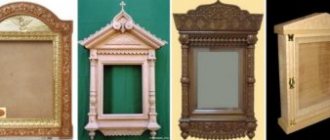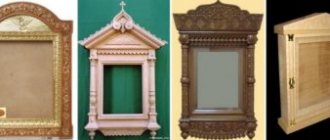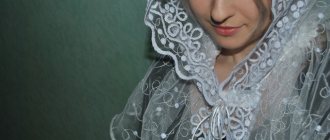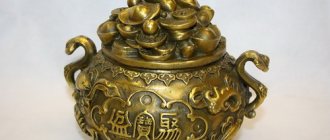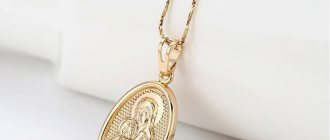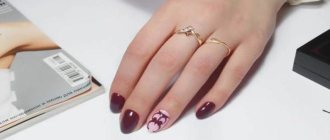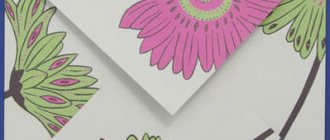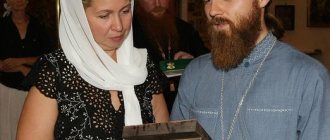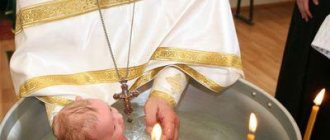Your own icon cabinet will fully meet your requirements, as well as satisfy requests for appearance, capacity and other parameters.
Yes, it will not be possible to assemble an iconostasis into a house or apartment. But making a shelf is quite possible. I propose to talk about how to make a shrine, and what is required for this.
You can take ideas from the photo. Or collect something of your own, unique, and also original. And then your idea will be copied and repeated in practice.
Location
A do-it-yourself corner shelf for icons must meet certain requirements, as well as Orthodox traditions. Today we are talking about them.
According to Orthodox canons, icons should be placed on the eastern wall. But it is also allowed to install them in a corner. But so that the iconostasis, and in our case the shelf, is directed to the east.
The corner design is small in size. To accommodate all the icons, it should be multi-tiered.
You can complement the product with a back wall, as well as threaded design on it. Usually, tiles, plants, and the outlines of saints are carved there. Some even make shelves with domes. But this is a question of individual skill.
When you have chosen the appropriate shape and size, you can move on to materials, as well as the selection of components for assembly.
Is it possible to hang an icon above the door?
Yes, you can, there are no prohibitions here. But you need to understand that an icon is not a talisman that can protect a house from ill-wishers. It is necessary at the entrance to the house only so that the person who enters and sees it can remember the name of God, pray, thank the higher powers, and ask for their intercession in any endeavors. As for what kind of icon can be hung above the front door, these are: “Savior on Ubrus”, “Seven Shot” (helps to reject bad thoughts), “Impenetrable Door” (helps to quickly overcome troubles and troubles), “Guardian Angel” ( removes unclean forces from household members and the house) and others. In principle, there are no restrictions.
What is needed for assembly
Traditionally, shelves for icons are made of wood and also of boards.
But in modern conditions, wood materials may be preferred. These are laminated chipboard, MDF, chipboard, plywood, etc. Plywood makes excellent shelves that can be decorated to your taste. Plus the material is easy to work with. It is not difficult to shape plywood to any size using ordinary tools.
Your build kit will consist of:
- any board 1.5-3 cm thick;
- a small sheet of plywood, chipboard or MDF to fit the size of the shelf;
- wood glue for wooden elements;
- sandpaper;
- varnish and paints;
- cutters with jigsaw;
- drills;
- lathe (preferably, but not required);
- hacksaws for cutting wood;
- pencil;
- rulers;
- hinges, dowels, and brackets.
You can decorate a shelf by carving or by imitation. Wood carving is a complex procedure and not accessible to everyone.
Burning out ornaments is much easier. You can use special templates. After burning, individual fragments are covered with enamel. This achieves the desired visual effect.
These are not racks for toys, and therefore the decor should be restrained, and also made according to the canons of Christianity.
Making elements of the future shelf
The future do-it-yourself corner shelf for icons consists of several elements. Namely from:
- side panels;
- shelves;
- racks;
- sides.
Determine the dimensions based on what shape you have, as well as where the structure will be located.
It can be straight or angular. Today we are interested in the second option. Although straight shelves are easier to make. As is the case with wall flower shelves.
Let's start assembling
See also:
Attic wardrobe: design options, which one to choose
Experience has shown that assembling an icon rack is somewhat more difficult than making a book holder. But anything is possible if you put in the effort.
The homemade shelf considered as an example will be based on fiberboard. Affordable and easy to process material. At the same time, it is quite reliable and durable.
The sequence of work will be as follows:
- Using a pencil and ruler, transfer the dimensions of the figure in the form of a right triangle onto a sheet of fiberboard. Use ready-made or your own drawings as a basis. It will be easier. I don’t recommend assembling and cutting by eye. Nothing good will come of it;
- The approximate dimensions of the figure will be 280x280x380 mm. You can use other dimensions;
- Using a jigsaw, preferably an electric one, cut out the shape along the drawn contour, and carefully sand the cut areas with sandpaper;
- Now you will need a sheet of veneer. It is better to take veneer with an adhesive layer and decorative film. Or additionally buy hot melt glue;
- On a sheet of veneer, draw a triangle of a similar shape. You can also cut with a regular sharp knife;
- Remove the protective film from the veneer sheet and glue the element to the chipboard triangle. For this you will need a hot iron;
- By analogy, make the required number of shelves. They will fit into the corner of the wall, and thereby repeat its shape;
- To connect the shelves together, use jumpers. They can be part of the connection elements, as well as additional decor;
- It is also advisable to provide sides on the icon panel. This will protect the icons from possible falling.
Decoration is at your discretion.
You can simply coat it with varnish or paint. Some apply patterns, draw or burn something, and also open it with colorless varnish. There are many options.
I think you won’t have any problems installing it on a wall in a corner of the room. It is enough to fasten a couple of hinges on the side parts of the shelf, then make holes in the walls, insert dowels, and tighten the screws. But this installation is completed.
Special placement instructions
At home, you are allowed to follow only the basic rules of placement.
- It is necessary to maintain symmetry and systematicity, to think through the compositional structure, which will help avoid feelings of internal dissatisfaction and the desire to change something. Incorrect arrangement distracts from the prayer service, the essence of which is concentration on petition and praise.
- An Orthodox person is obliged to remember the principle of church hierarchy: locally revered icons cannot be placed above the main ones (Christ the Savior, the Virgin Mary and the Holy Trinity).
- The image of the Messiah must be placed on the right side of the upcoming believer, and the canvas with the face of the Virgin Mary on the left. When selecting an iconostasis, one should focus on the uniformity of artistic execution of the shrines. The Church is not recommended to allow diversity in styles.
- Orthodox people must take holiness very seriously, since it is one of the properties of God himself. This quality is reflected in heavenly saints and material objects. It follows: the veneration of holy governors and iconographies belongs to the same religious order.
- The degree of churching of a family is judged by the reverence that members show to the faces of Christ and the Mother of God. Ancestral icons have always been greatly revered. The newly baptized baby was brought to the shrine, and the priest read prayers praising God. In ancient times, through the icon, parents blessed their children for successful studies, travel to distant lands, and service to society. Before a wedding or after the death of a person, believers also turned to the saints for help.
- If an iconostasis is placed in the house, quarrels, disgusting behavior, and scandals on various topics are unacceptable. However, an overly reverent attitude towards shrines should not be transformed into idolatry. We must remember: icons are a divine image, but not the very personality of the Lord or His vicegerents.
- A canvas that has fallen into complete disrepair and cannot be restored cannot be thrown away; it must be treated with due respect and respect as an ancient tablet. Previously, if the colors on an icon were washed off, it was sent down the river. Today, such a rarity is taken to the church, where it is burned in the temple oven.
- If damage to the face occurred due to careless storage, one should confess, since the Church considers such irresponsibility a sin.
Important! The Savior, the Mother of God, the apostles and saints looking from the canvases belong to eternity. When asking them for intercession through prayer, we - residents of areas of sorrow - need to always remember the Almighty Creator, the call to voluntary repentance, self-improvement and mercy. Through the eyes of saints, the Almighty looks at people and reminds us that we have the opportunity to save our souls.
What to put where
See also
Do-it-yourself toy rack for a nursery using improvised materials
The question is purely religious. But I understand a little about it. That’s why I want to give you some advice.
If we proceed from the traditions of the Orthodox Church, then the corner icon stand should have 3 shelves. These are 3 rows, each of which has its own meaning.
There is a sequence in which the icons are arranged on these tiers:
- An icon of Jesus is always placed on the top tier. To her left should be the Mother of God, and to her right John the Baptist. If there is enough space, then on the left there will be an icon depicting Michael, and on the right, accordingly, Gabriel;
- Space on the middle shelf is reserved for holiday icons. Here they place images of the most significant holidays in the life of Orthodox Christians. In theory, there should be as many as 12 of them. But if there is not enough space for everyone, then choose at your own discretion;
- The lowest tier is reserved for holy faces associated with the residents of this house or apartment. That’s why the bottom shelf is called local.
What is most interesting is that it is the corner structures that are more consistent with the canons and traditions of the Orthodox Church. After all, the icon is located in the so-called red corner.
Where to place a home iconostasis
Since ancient times, the far right corner of the room was chosen for this. It's good if it's in the east. The houses of villagers in past centuries had many windows. The “Red Corner” was built where two walls with windows met. This was the most illuminated place in the house, ideal for a home iconostasis. Today such a tradition is becoming a thing of the past.
Modern interior design does not always allow us to create a place for prayer where our ancestors did. The home iconostasis is placed based on the following rules:
- Ensuring a free approach. A person should feel free when praying. The faces of the saints are open; they cannot be blocked by extraneous things.
- The location of the home iconostasis should be at eye level and above.
- The organization of the place for the iconostasis should include the installation of a lamp or candle. In this place it should be possible to place Orthodox items - an Easter egg, a palm branch from Palm Sunday or a bouquet of flowers and herbs from the Trinity holiday.
- Eliminate the presence of household appliances, decorative items, books and other things near the home iconostasis that go against the Orthodox religion.
- Remove photographic portraits from the Red Corner.
